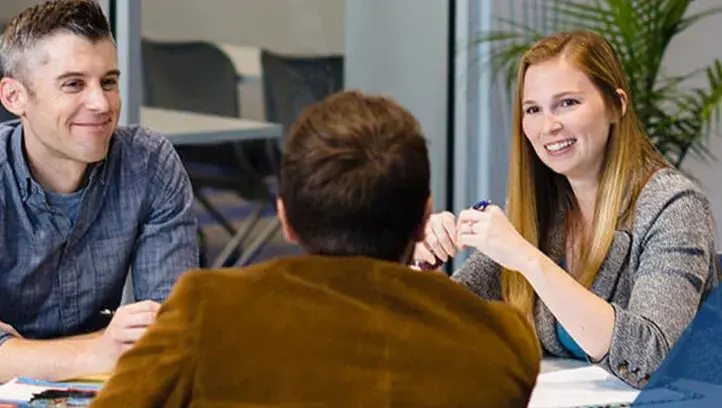
Critical thinking: What it is and why it matters

How many times have you lamented that a colleague or member of your social circle failed (yet again) to use his or her critical thinking skills? It may be an exasperatingly familiar refrain.
Just as common sense is often uncommon, critical thinking is also frequently in short supply. But it’s never more needed, especially as a core leadership competency in our places of work, be it a classroom, a conference room or an operating room.
Today’s businesses – indeed, our society – demand leaders who gather and synthesize information from many different sources. Unfortunately, there are psychological, cultural and even practical barriers that impede our ability to think critically.
Critical Thinking Defined
Associate Professor of Management and Chair of the Marketing and Management Department at Creighton University’s Heider College of Business, Lance Frazier, PhD, offers the following definition of critical thinking: “A process of actively conceptualizing, thinking, reasoning, rationalizing and evaluating information in some attempt to make a decision, or to use that information to share our beliefs or to take action.”
Leah Georges, PhD, associate professor and program director in Creighton University’s doctoral program in Interdisciplinary Leadership, discusses the essentialness of critical thinking to leadership with Frazier in an episode of the “Growth Edge Leadership Podcast.
According to Georges, critical thinking need not culminate in a certain opinion. It’s the process, not the end result, that matters. “But that’s where critical thinking becomes more fun to talk about than ‘what’s the decision you made?’ We can just think about critical thinking as ‘thinking’ sometimes.”
Putting it into Practice
We live in an increasingly diverse, dynamic and interdependent world. As individuals, and particularly as leaders, the importance of the awareness that critical thinking fosters cannot be overstated. Even as well-trained professionals, we can easily succumb to bias or suffer blind spots. Critical thinking calls us to live a life that is better examined, to dig deeper, to mine for new knowledge, to step back and ensure that there’s not a counterpoint worthy of consideration.
Our society and most organizations tend to value confidence, which is perceived as strength. Yet, there is a danger in overconfidence. This attribute – and its cousin, hubris – present barriers to critical, nuanced, intentional thinking. There are consequences of being loud and wrong, of failing to consider the implications beyond the moment and in a discerning manner.
This approach to thinking, problem-solving and decision-making represents a heuristic method or mental shortcut, making us “cognitive misers,” says Georges.
When we’re busy, it is easy to fall back on what we already know. Plus, it just feels good to be “right.” This is where confirmation bias comes into play. We may consistently fall back on what is safe – the person, platform or outlet that substantiates what we think we already know. It is vital to go back, identify if the information you are confirming is an assumption and not a fact, and to then question it.
The digital ecosystem does us no favors on these fronts. Social media algorithms are already stacked against those of us who endeavor to thinking critically. It is amazing how quickly a little broadening of one’s echo chamber can alter those algorithms and the type of information, advertising and other content one encounters.
Psychological Safety: What it is, Why it Matters
Critical thinking should be nurtured in the workplace. As leaders, let’s build an environment that encourages team members at all levels to take smart risks and ask the hard questions without fear of retribution. Such interpersonal risks align with critical thinking because talent with a psychological safety net can comfortably and confidently defy norms, challenge assumptions or processes, and experiment (even if a failure is the result of doing so).
A culture of critical thinking pushes us all to do and be better.
And a diverse and inclusive workforce, in turn, fosters an environment where all feel safe to challenge the inherent biases or outdated practices that ultimately constrain our ability to adapt and thrive.
Yes, critical thinking may not be as natural as you may have assumed. But fortunately, this skill can be learned. Here are a few practices to build that muscle by putting it to work:
- Look at critical thinking through the lens of a less buzzy and better understood word: “curiosity.” Channel a child’s joy in discovering the new – new solutions to problems or new lenses through which to see the world.
- Create a culture of critical thinking. It is not sufficient to have a workshop here or a presentation there. Hire for it, reward it, promote for it and hold your entire organization accountable for the practice of it.
- Lead by example. Be intentional in how you model critical thinking and reflection. Honor intellectual humility. Pursue self-awareness and self-lessness.
- Do not merely listen, empathize. Even when another’s belief is diametrically opposed to your own, seek to understand where that person is coming from. Do not be dismissive. Consider what truth or value might lie within.
- Pursue feedback. Do not retreat to the safety of being “yes men (or women).” Actively find ways to learn the hard truths about yourself so that you can challenge the assumptions or beliefs that you hold about yourself.
- Shatter the echo chamber. Seek diversity in your sources of information. Follow a new voice on X. Read beyond your usual go-to thought leaders. Unfollow those whose ideas are predictably familiar to your own.
- Be a lifelong learner. Critical thinking is a byproduct of open-mindedness and a thirst for knowledge.
- In closing, consider this wisdom from the great Maya Angelou: “Do the best until you know better. Then when you know better, do better.”
Equal parts encouraging and exhausting, this approach to leadership and life is aided considerably by critical thinking and all of the attributes of wonder, reflection and objectivity that go along with it. Congrats to being a better leader than you were one year ago, and cheers to being a better leader one year from today than you are today!




